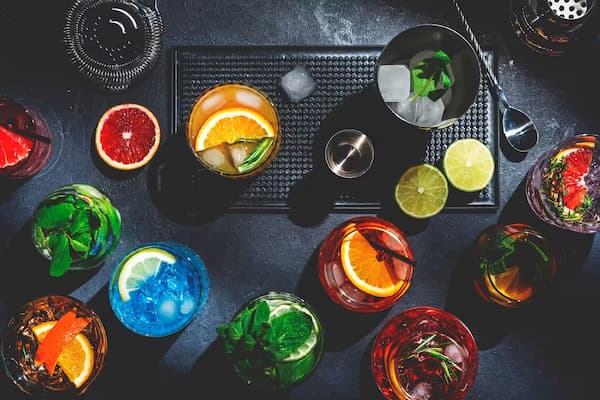Jelly
About Jelly
In the realm of cocktails, jelly can serve multiple roles. It can be used as a base for the concoction, wherein the alcohol is mixed with the jelly ingredients before setting, resulting in a gelatinous treat that requires eating rather than drinking. This method is popular in creating boozy desserts or party shots, where the jelly is often set in small molds or shot glasses. Alcohol types like vodka, rum, or tequila are commonly used due to their versatility in mixing with different flavors.
Additionally, jelly can be employed as a novel garnish or an actual ingredient in the drink, lending both texture and layers of flavor. For instance, a dollop of jelly can be added to a cocktail, melting slowly to change the drink's character as it is consumed. Alternatively, bartenders can use jelly cubes as an edible garnish that adds a playful element to the presentation. The use of jelly in cocktails is limited only by the mixologist's creativity, allowing for endless possibilities in creating unique and memorable drinking experiences.
Q&A
What is the history behind using jelly in cocktails and mixology?
The use of jelly in cocktails and mixology can trace its roots back to the culinary experimentation of the 18th and 19th centuries, when gelatin (the key ingredient in jelly) became more widely available. Initially, gelatin was used in elaborate desserts and aspics among the upper classes. However, as the technology and production methods evolved, gelatin and, consequently, jelly became accessible to a wider audience. The playful and versatile nature of jelly caught the imagination of early mixologists who began incorporating it into alcoholic creations for an added texture and flavor dimension. The Prohibition era in the United States saw a rise in its innovative use to conceal the taste of poorly made illegal spirits. Over time, the concept of jellying cocktails has evolved from a novelty to a craft, allowing for intricate flavor layering and presentation techniques in modern mixology.
What types of alcohol work best when making alcoholic jelly?
When making alcoholic jelly, spirits with a clear and neutral flavor profile, such as vodka, are often preferred due to their versatility and ability to mix well with a wide range of jelly flavors without overpowering them. However, for a richer or more nuanced flavor, one can also use rum, tequila, or gin. The choice of alcohol depends largely on the desired taste and the type of jelly being used. For instance, a citrus-based jelly might pair well with gin due to its botanical notes, whereas a berry jelly could complement the warmth of rum. It's important to note that the alcohol content should be adjusted to maintain the jelly's ability to set properly.
How can jelly be used as an innovative garnish in cocktails?
Jelly can be creatively used as a garnish in cocktails in several ways to add a splash of color, texture, and flavor. Cutting jelly into cubes or other shapes and adding them to drinks not only makes them visually appealing but also introduces a playful element as the jelly slowly dissolves. Additionally, layering different flavored jellies in a glass can create an eye-catching effect. For a more sophisticated presentation, shaping jelly into spheres or using it to encapsulate edible flowers or herbs before adding it to the cocktail can elevate the overall aesthetic and experience. Jelly garnishes work exceptionally well in clear or lightly colored cocktails where their vibrant colors and textures can really shine.
What is the recommended process for incorporating jelly into a cocktail?
Incorporating jelly into a cocktail involves a careful balance of creativity and technique. To start, choose a jelly that complements the flavor profile of your cocktail. If you’re using jelly as a base, dissolve it according to the package instructions, then mix it with the desired amount of cold alcohol and let it set in the refrigerator. For a jelly-based mix, it's crucial to adjust the amount of boiling water to ensure the alcohol doesn't prevent the jelly from setting. Alternatively, adding small cubes or dollops of pre-made jelly directly to the drink allows it to slowly blend with the cocktail, enriching its flavor and texture. Experiment with different placements, such as at the bottom of the glass for a visual effect or as a floating garnish for an interactive experience.
Are there non-alcoholic variations of jelly cocktails, and how can they be made?
Yes, non-alcoholic variations of jelly cocktails, often called mocktails or jelly mocktails, can be a delightful way to enjoy the fun and creativity of jelly-infused drinks without the alcohol. To create these, use a non-alcoholic base such as fruit juice, herbal teas, or soda in place of the alcohol when preparing the jelly. You can also explore layering different flavors of non-alcoholic jellies in a glass, adding fresh fruit or edible flowers for garnish, or incorporating carbonated beverages for a fizzy effect. Not only do jelly mocktails offer a unique texture and taste experience, but they also make for an inclusive option that can be enjoyed by guests of all ages at parties and gatherings.
Ingredients like Jelly
Other Kitchen cupboards
How it works
Easily create your bar from the ingredients you have at home, and we'll show you what you can make with the ingredients you have to hand.
Once you've added this ingredient head to your My bar page and fill up everything else you have.
We'll also show you cocktails that can make by substituting what you have for one of the ingredients you don't, riffing on the original. Now go forth and create something delicious!












































